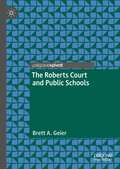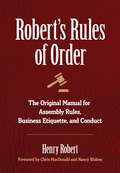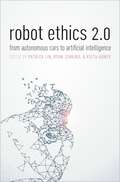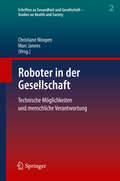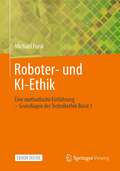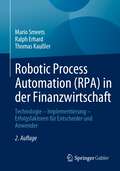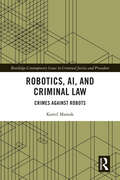- Table View
- List View
Roberto Esposito: Law, Community and the Political (Nomikoi: Critical Legal Thinkers)
by Peter LangfordRoberto Esposito: Law, Community and the Political provides a critical legal introduction to this increasingly influential Italian theorist’s work, by focusing on Esposito’s reconceptualisation of the relationship between law, community and the political. The analysis concentrates primarily on Esposito’s Catégories de l’Impolitique, Communitas, Immunitas and Bíos, which, it is argued, are animated by an abiding concern with the position of critique in relation to the tradition of modern and contemporary legal and political philosophy. Esposito’s fundamental rethinking of these notions breaks with the existing framework of political and legal philosophy, through the critique of its underlying presuppositions. And, in the process, Esposito rethinks the very form of critique. As the first monograph-length study of Esposito in English, Roberto Esposito: Law, Community and the Political will be of considerable interest to those working in the areas of contemporary legal and political thought and philosophy.
Roberto Esposito: Law, Community and the Political (Nomikoi: Critical Legal Thinkers)
by Peter LangfordRoberto Esposito: Law, Community and the Political provides a critical legal introduction to this increasingly influential Italian theorist’s work, by focusing on Esposito’s reconceptualisation of the relationship between law, community and the political. The analysis concentrates primarily on Esposito’s Catégories de l’Impolitique, Communitas, Immunitas and Bíos, which, it is argued, are animated by an abiding concern with the position of critique in relation to the tradition of modern and contemporary legal and political philosophy. Esposito’s fundamental rethinking of these notions breaks with the existing framework of political and legal philosophy, through the critique of its underlying presuppositions. And, in the process, Esposito rethinks the very form of critique. As the first monograph-length study of Esposito in English, Roberto Esposito: Law, Community and the Political will be of considerable interest to those working in the areas of contemporary legal and political thought and philosophy.
The Roberts Court and Public Schools
by Brett A. GeierThis unique and timely book offers a synthesis, analysis, and evaluation of education-related rulings of the US Supreme Court from 2005 to the present. Throughout the course of the twentieth century into the twenty-first century, the Supreme Court issued rulings, which frequently vacillate based on the political composition of the justices who sit on the bench. Chapters will cover both an overview of the role of Supreme Court rulings in school policy and the court’s transformation in the late twentieth century into the present day. These themes will be converted into robust chapters which will provide a legal analysis of the Roberts Court years, and an evaluation of the jurisprudence and its practical effect on public schools.
Robert's Rules of Order: The Original Manual for Assembly Rules, Business Etiquette, and Conduct (Little Books Of Wisdom Ser.)
by Henry Robert Chris MacDonaldRobert’s Rules of Order was originally published in 1876, as a guide for groups when they met to maximize the efficiency of their meetings and conduct their business in an orderly fashion. The book highlights how to properly motion for an argument or change, and the subsequent steps required for a motion to pass. Additionally, it elaborates on decorum, etiquette, voting procedures, positions within the group, and more. With a new foreword by Chris MacDonald, author of The Business Ethics Blog, this edition is sure to provide readers with the most comprehensive version of Robert’s classic guide. It’s sure to make meetings run more smoothly, and help whatever your cause achieve greater success.
Robert’s Rules of Order, and Why It Matters for Colleges and Universities Today
by Henry Martyn Robert Christopher P. LossA critical edition of the book that paved the way for the democratization of American higher educationIf you have ever attended a town meeting or business lunch, or participated in a church group or department meeting, or served on a faculty senate or maybe just watched C-SPAN, then you have likely encountered Robert's Rules of Order. This critical edition of Henry M. Robert's essential guide to parliamentary procedure features the original text from 1876 along with a companion essay by Christopher Loss, who artfully recounts the book's publication and popular reception, and sheds light on its enduring value for one of the most vital bastions of democracy itself—the modern university.Loss deftly explains why Robert's simple, elegant handbook to democratic governance captured the imagination of so many ordinary citizens during the Gilded Age and how it has shaped the development of our colleges and universities ever since. He shows how Robert's rules can help faculty, administrators, and students to solve problems and overcome challenges through collaboration, disciplined thinking, trust in the facts, and honesty and fairness from all sides.At a time when people's faith in democracy and higher education has been shaken to its core, Robert's Rules of Order offers a powerful reminder of the importance of democratic norms and practices in American life and institutions.
Robert’s Rules of Order, and Why It Matters for Colleges and Universities Today
by Henry Martyn Robert Christopher P. LossA critical edition of the book that paved the way for the democratization of American higher educationIf you have ever attended a town meeting or business lunch, or participated in a church group or department meeting, or served on a faculty senate or maybe just watched C-SPAN, then you have likely encountered Robert's Rules of Order. This critical edition of Henry M. Robert's essential guide to parliamentary procedure features the original text from 1876 along with a companion essay by Christopher Loss, who artfully recounts the book's publication and popular reception, and sheds light on its enduring value for one of the most vital bastions of democracy itself—the modern university.Loss deftly explains why Robert's simple, elegant handbook to democratic governance captured the imagination of so many ordinary citizens during the Gilded Age and how it has shaped the development of our colleges and universities ever since. He shows how Robert's rules can help faculty, administrators, and students to solve problems and overcome challenges through collaboration, disciplined thinking, trust in the facts, and honesty and fairness from all sides.At a time when people's faith in democracy and higher education has been shaken to its core, Robert's Rules of Order offers a powerful reminder of the importance of democratic norms and practices in American life and institutions.
Robert's Rules of Order Newly Revised, 12th edition
by Daniel H. Honemann Thomas J. Balch Shmuel Gerber Daniel E. Seabold Henry M. Robert, IIIThe only current authorized edition of the classic work on parliamentary procedure--now in a new updated editionRobert's Rules of Order is the recognized guide to smooth, orderly, and fairly conducted meetings. This 12th edition is the only current manual to have been maintained and updated since 1876 under the continuing program established by General Henry M. Robert himself. As indispensable now as the original edition was more than a century ago, Robert's Rules of Order Newly Revised is the acknowledged "gold standard" for meeting rules. New and enhanced features of this edition include:Section-based paragraph numbering to facilitate cross-references and e-book compatibility Expanded appendix of charts, tables, and listsSample rules for electronic meetingsHelpful summary explanations about postponing a motion, reconsidering a vote, making and enforcing points of order and appeals, and newly expanded procedures for filling blanksNew provisions regarding debate on nominations, reopening nominations, and completing an election after its scheduled timeDozens more clarifications, additions, and refinements to improve the presentation of existing rules, incorporate new interpretations, and address common inquiries Coinciding with publication of the 12th edition, the authors of this manual have once again published an updated (3rd) edition of Robert's Rules of Order Newly Revised In Brief, a simple and concise introductory guide cross-referenced to it.
Robert's Rules of Order Newly Revised In Brief, 2nd edition
by Henry M. Robert Daniel H. Honemann Thomas J. BalchThe only authorized edition of the classic work on parliamentary procedure, with new and enhanced features, including how to conduct electronic meetingsRobert's Rules of Order is the book on parliamentary procedure for parliamentarians and anyone involved in an organization, association, club, or group and the authoritative guide to smooth, orderly, and fairly conducted meetings and assemblies. This newly revised edition is the only book on parliamentary procedure to have been updated since 1876 under the continuing program of review established by General Henry M. Robert himself, in cooperation with the official publisher of Robert's Rules. The eleventh edition has been thoroughly revised to address common inquiries and incorporate new rules, interpretations, and procedures made necessary by the evolution of parliamentary procedure, including new material relating to electronic communication and "electronic meetings."
Robert's Rules of Order Newly Revised In Brief, 3rd edition
by Daniel H. Honemann Thomas J. Balch Shmuel Gerber Daniel E. Seabold Henry M. Robert, IIIA short, concise and user-friendly guide to the essential procedures of conducting a meeting, written by the authors of Robert's Rules of Order Newly Revised, the only authorized edition of the classic work on parliamentary procedure Originally published in 1876, General Henry M. Robert's guide to smooth, orderly, and fairly conducted meetings has sold over six million copies in eleven editions. Robert's Rules of Order is the book on parliamentary proceedings, yet those not well versed on what has now become a rather thick document can find themselves lost-and delayed-while trying to locate the most important rules. The solution? Robert's Rules of Order Newly Revised in Brief.Written by the same authorship team behind the officially sanctioned Robert's Rules of Order, this short and user-friendly edition takes readers through the rules most often needed at meetings--from debates to amendments to nominations. With sample dialogues and a guide to using the complete edition, Robert's Rules of Order Newly Revised in Brief is the essential handbook for parliamentary proceedings.
Roberts & Zuckerman's Criminal Evidence
by Paul RobertsRoberts and Zuckerman's Criminal Evidence is the eagerly-anticipated third of edition of the market-leading text on criminal evidence, fully revised to take account of developments in legislation, case-law, policy debates, and academic commentary during the decade since the previous edition was published. With an explicit focus on the rules and principles of criminal trial procedure, Roberts and Zuckerman's Criminal Evidence develops a coherent account of evidence law which is doctrinally detailed, securely grounded in a normative theoretical framework, and sensitive to the institutional and socio-legal factors shaping criminal litigation in practice. The book is designed to be accessible to the beginner, informative to the criminal court judge or legal practitioner, and thought-provoking to the advanced student and scholar: a textbook and monograph rolled into one. The book also provides an ideal disciplinary map and work of reference to introduce non-lawyers (including forensic scientists and other expert witnesses) to the foundational assumptions and technical intricacies of criminal trial procedure in England and Wales, and will be an invaluable resource for courts, lawyers and scholars in other jurisdictions seeking comparative insight and understanding of evidentiary regulation in the common law tradition.
Roberts & Zuckerman's Criminal Evidence
by Paul Roberts Adrian ZuckermanRoberts and Zuckerman's Criminal Evidence is the eagerly-anticipated third of edition of the market-leading text on criminal evidence, fully revised to take account of developments in legislation, case-law, policy debates, and academic commentary during the decade since the previous edition was published. With an explicit focus on the rules and principles of criminal trial procedure, Roberts and Zuckerman's Criminal Evidence develops a coherent account of evidence law which is doctrinally detailed, securely grounded in a normative theoretical framework, and sensitive to the institutional and socio-legal factors shaping criminal litigation in practice. The book is designed to be accessible to the beginner, informative to the criminal court judge or legal practitioner, and thought-provoking to the advanced student and scholar: a textbook and monograph rolled into one. The book also provides an ideal disciplinary map and work of reference to introduce non-lawyers (including forensic scientists and other expert witnesses) to the foundational assumptions and technical intricacies of criminal trial procedure in England and Wales, and will be an invaluable resource for courts, lawyers and scholars in other jurisdictions seeking comparative insight and understanding of evidentiary regulation in the common law tradition.
Roboethics: A Navigating Overview (Intelligent Systems, Control and Automation: Science and Engineering #1046)
by Spyros G. TzafestasThis volume explores the ethical questions that arise in the development, creation and use of robots that are capable of semiautonomous or autonomous decision making and human-like action. It examines how ethical and moral theories can and must be applied to address the complex and critical issues of the application of these intelligent robots in society.Coverage first presents fundamental concepts and provides a general overview of ethics, artificial intelligence and robotics. Next, the book studies all principal ethical applications of robots, namely medical, assistive, socialized and war roboethics. It looks at such issues as robotic surgery, children-robot and elderly-robot therapeutical/social interactions and the use of robots, especially autonomous lethal ones, in warfare. In addition, a chapter also considers Japanese roboethics as well as key intercultural and robot legislation issues. Overall, readers are provided with a thorough investigation into the moral responsibility (if any) of autonomous robots when doing harm. This volume will serve as an ideal educational source in engineering and robotics courses as well as an introductory reference for researchers in the field.
Robot Ethics 2.0: From Autonomous Cars to Artificial Intelligence
The robot population is rising on Earth and other planets. (Mars is inhabited entirely by robots.) As robots slip into more domains of human life--from the operating room to the bedroom--they take on our morally important tasks and decisions, as well as create new risks from psychological to physical. This makes it all the more urgent to study their ethical, legal, and policy impacts. To help the robotics industry and broader society, we need to not only press ahead on a wide range of issues, but also identify new ones emerging as quickly as the field is evolving. For instance, where military robots had received much attention in the past (and are still controversial today), this volume looks toward autonomous cars here as an important case study that cuts across diverse issues, from liability to psychology to trust and more. And because robotics feeds into and is fed by AI, the Internet of Things, and other cognate fields, robot ethics must also reach into those domains, too. Expanding these discussions also means listening to new voices; robot ethics is no longer the concern of a handful of scholars. Experts from different academic disciplines and geographical areas are now playing vital roles in shaping ethical, legal, and policy discussions worldwide. So, for a more complete study, the editors of this volume look beyond the usual suspects for the latest thinking. Many of the views as represented in this cutting-edge volume are provocative--but also what we need to push forward in unfamiliar territory.
ROBOT ETHICS 2.0 C: From Autonomous Cars to Artificial Intelligence
by Patrick Lin, Ryan Jenkins, and Keith AbneyThe robot population is rising on Earth and other planets. (Mars is inhabited entirely by robots.) As robots slip into more domains of human life--from the operating room to the bedroom--they take on our morally important tasks and decisions, as well as create new risks from psychological to physical. This makes it all the more urgent to study their ethical, legal, and policy impacts. To help the robotics industry and broader society, we need to not only press ahead on a wide range of issues, but also identify new ones emerging as quickly as the field is evolving. For instance, where military robots had received much attention in the past (and are still controversial today), this volume looks toward autonomous cars here as an important case study that cuts across diverse issues, from liability to psychology to trust and more. And because robotics feeds into and is fed by AI, the Internet of Things, and other cognate fields, robot ethics must also reach into those domains, too. Expanding these discussions also means listening to new voices; robot ethics is no longer the concern of a handful of scholars. Experts from different academic disciplines and geographical areas are now playing vital roles in shaping ethical, legal, and policy discussions worldwide. So, for a more complete study, the editors of this volume look beyond the usual suspects for the latest thinking. Many of the views as represented in this cutting-edge volume are provocative--but also what we need to push forward in unfamiliar territory.
Robot Ethics and the Innovation Economy (Routledge Studies in the Economics of Innovation)
by Jon-Arild JohannessenThis book provides an authoritative resource on the topic of intelligent robots, artificial intelligence and the ethical implications of these revolutionary innovations. It examines the moral and ethical problems that arise in relation to the development, design and use of intelligent robots, which are capable of autonomous or semi-autonomous decision-making. These problems might relate, for example, to medical robots, driverless cars, intelligent military drones, pedagogical robots, police robots, legal robots and many others. The main question addressed in this book is how we can understand, explain and apply the concept of ethics in relation to intelligent robots and artificial intelligence. In each chapter, the author examines a different aspect of this question. The author also questions how we can ensure that intelligent robots are of service to humans and under what conditions intelligent robots could become more ethical than humans. The book employs an original approach to examining this cutting-edge research question, combining different research areas, and offers a wealth of practical relevance and real-world examples, illustrated through vivid case studies. With its jargon free approach and a dedicated chapter on relevant concepts at the end, this book is also accessible to readers without prior knowledge on intelligent robots and the Fourth Industrial Revolution. By providing a general account of this debate, and of the consequences of the innovations resulting from these trends, the book serves as an important contribution to the discussion and will find a natural readership among scholars and students of the innovation economy and those concerned with the ethical considerations arising in the wake of the Fourth Industrial Revolution
Robot Ethics and the Innovation Economy (Routledge Studies in the Economics of Innovation)
by Jon-Arild JohannessenThis book provides an authoritative resource on the topic of intelligent robots, artificial intelligence and the ethical implications of these revolutionary innovations. It examines the moral and ethical problems that arise in relation to the development, design and use of intelligent robots, which are capable of autonomous or semi-autonomous decision-making. These problems might relate, for example, to medical robots, driverless cars, intelligent military drones, pedagogical robots, police robots, legal robots and many others. The main question addressed in this book is how we can understand, explain and apply the concept of ethics in relation to intelligent robots and artificial intelligence. In each chapter, the author examines a different aspect of this question. The author also questions how we can ensure that intelligent robots are of service to humans and under what conditions intelligent robots could become more ethical than humans. The book employs an original approach to examining this cutting-edge research question, combining different research areas, and offers a wealth of practical relevance and real-world examples, illustrated through vivid case studies. With its jargon free approach and a dedicated chapter on relevant concepts at the end, this book is also accessible to readers without prior knowledge on intelligent robots and the Fourth Industrial Revolution. By providing a general account of this debate, and of the consequences of the innovations resulting from these trends, the book serves as an important contribution to the discussion and will find a natural readership among scholars and students of the innovation economy and those concerned with the ethical considerations arising in the wake of the Fourth Industrial Revolution
Robot Intelligence Technology and Applications 3: Results from the 3rd International Conference on Robot Intelligence Technology and Applications (Advances in Intelligent Systems and Computing #345)
by Jong-Hwan Kim Weimin Yang Jun Jo Peter Sincak Hyun MyungThis book covers all aspects of robot intelligence from perception at sensor level and reasoning at cognitive level to behavior planning at execution level for each low level segment of the machine. It also presents the technologies for cognitive reasoning, social interaction with humans, behavior generation, ability to cooperate with other robots, ambience awareness, and an artificial genome that can be passed on to other robots. These technologies are to materialize cognitive intelligence, social intelligence, behavioral intelligence, collective intelligence, ambient intelligence and genetic intelligence. The book aims at serving researchers and practitioners with a timely dissemination of the recent progress on robot intelligence technology and its applications, based on a collection of papers presented at the 3rd International Conference on Robot Intelligence Technology and Applications (RiTA), held in Beijing, China, November 6 - 8, 2014. For better readability, this edition has the total 74 papers grouped into 3 chapters: Chapter I: Ambient, Behavioral, Cognitive, Collective, and Social Robot Intelligence, Chapter II: Computational Intelligence and Intelligent Design for Advanced Robotics, Chapter III: Applications of Robot Intelligence Technology, where individual chapters, edited respectively by Peter Sincak, Hyun Myung, Jun Jo along with Weimin Yang and Jong-Hwan Kim, begin with a brief introduction written by the respective chapter editors.
Roboter in der Gesellschaft: Technische Möglichkeiten und menschliche Verantwortung (Schriften zu Gesundheit und Gesellschaft - Studies on Health and Society #2)
by Christiane Woopen Marc JannesDas Buch betrachtet den Einsatz der Robotik in Gesundheit, Wirtschafts- und Arbeitswelt aus interdisziplinärer Perspektive. Immer eigenständigere Roboter halten Einzug in unseren Alltag. Bereits heute übernehmen sie eine Vielzahl von Aufgaben z. B. in der produzierenden Industrie oder der Medizin. Diese maschinellen Systeme agieren in atemberaubendem Tempo immer unabhängiger von menschlicher Steuerung. In zunehmendem Maße sind sie in der Lage, auch komplexere Schlussfolgerungen zu ziehen. All dies wirft eine Vielzahl ethischer und juristischer Fragen auf: Wie verändern automatisierte Systeme unser Leben und Selbstverständnis? Vor welchen Herausforderungen stehen Arbeitswelt, öffentlicher Raum und Pflege? Experten aus Wissenschaft und Politik beleuchten diese und weitere Fragen innerhalb des vorliegenden Bandes.
Roboter- und KI-Ethik: Eine methodische Einführung – Grundlagen der Technikethik Band 1
by Michael FunkWas ist die Ethik der Roboter? Was ist KI-Ethik? Was sind „moralische Maschinen“? Welchen Gesetzen sollen sie folgen? Haben wir die Roboter, die wir brauchen, und brauchen wir die Roboter, die wir haben?In vorliegendem Buch werden Grundlagen der Ethik im Umgang mit Robotern, Drohnen und KI allgemeinverständlich dargestellt. Hierzu zählt die Unterscheidung von Moral, Ethik und Ethos sowie deren Anwendung auf Menschen und Maschinen. Kriterien, Fehlschlüsse und Robotergesetze werden vorgestellt, wie auch in die umfassende Gegenwartsdebatte übersichtlich eingeführt. Grafiken und Beispiele bieten Orientierung in einem hochaktuellen und komplexen Feld.Als methodische Einführung richtet sich vorliegendes Buch an Ingenieurwissenschaftler*innen, Informatiker*innen und Geisteswissenschaftler*innen im Berufsalltag, aber auch an interessierte Lai*innen, die Grundlagen der Ethik kennen lernen wollen. Es bildet den ersten, in sich abgerundeten Teil der Buchreihe Grundlagen der Technikethik.Mit einem Geleitwort von Yvonne Hofstetter.
Robotic Process Automation im Einsatz: Strategische Ausrichtung – praktische Umsetzung – revisionssichere Implementierung
by Mario Richard Smeets Ralf Jürgen Ostendorf Andreas FreßmannSeit einigen Jahren beschäftigt die Automatisierung beliebiger Prozesse und Prozessschritte mit der RPA-Technologie die Finanzwirtschaft. Mittlerweile aus dem Alltag vieler sachbearbeitenden Bereiche nicht mehr wegzudenken. Wie funktioniert die Technologie, wer trägt die Verantwortung und was sind die Risiken eines Einsatzes in der eigenen Bank? Das Buch beantwortet diese und viele verwandte Fragen zu RPA, die sich insbesondere interne und externe Prüfer, aber auch Entscheider stellen. Neben einer Einführung in die Technologie und der Einordnung in einen weitgefassten, strategischen Kontext, wird insbesondere die Thematik der richtigen "Prüfung und Beurteilung" der Technologie diskutiert.
Robotic Process Automation (RPA) - Digitalisierung und Automatisierung von Prozessen: Voraussetzungen, Funktionsweise und Implementierung am Beispiel des Controllings und Rechnungswesens
by Christian Langmann Daniel TuriDas vorliegende Buch gibt einen praxisorientierten Überblick über die notwendigen Voraussetzungen, die Funktionsweise sowie die einzelnen Schritte für die erfolgreiche Einführung von Robotic Process Automation (RPA). Neben theoretischen Grundlagen verdeutlichen Umsetzungsbeispiele aus der Praxis aus Controlling und Rechnungswesen das enorme Potenzial dieser Technologie.
Robotic Process Automation (RPA) in der Finanzwirtschaft: Technologie – Implementierung – Erfolgsfaktoren für Entscheider und Anwender
by Mario Smeets Ralph Erhard Thomas KaußlerDieses Buch bringt Ihnen die Robotic Process Automation in der Finanzwirtschaft näher In der Finanzbranche ist das Thema Prozessautomatisierung seit Jahren nicht mehr wegzudenken. Doch wie setzt man solche Veränderungen im Rahmen des Changemanagements erfolgreich und effizient um? Das Buch „Robotic Process Automation in der Finanzwirtschaft“ zeigt es Ihnen. Im Fokus steht der recht junge RPA-Ansatz aus der Intelligent Automation. Dabei imitieren Roboter das menschliche Handeln. Die Eingabe von Befehlen erfolgt direkt über die Oberfläche. So gehören tiefgreifende Softwareveränderungen der Vergangenheit an. Im Zuge dessen klärt dieses Buch u. a. folgende Fragen bezüglich der Robotic Process Automation in der Finanzwirtschaft: • Was ist RPA überhaupt? • Welche Vorteile bringt diese Technologie mit sich? • Welche Erfolgsfaktoren tragen zu einer optimalen RPA-Implementierung bei? • Wie sieht ein mögliches RPA-Kompetenzcenter aus? • Welche Anwendungsbereiche für RPA gibt es? Eine Leseempfehlung für ein breites Zielpublikum Daneben beschäftigen sich die Autoren nicht nur mit dem Ist-Zustand der Robotic Process Automation. Zudem erhalten Sie einen Ausblick auf die zukünftige Entwicklung dieser Software-Lösung. Durch den hohen Praxisbezug ist das Buch speziell für folgende Zielgruppen eine lesenswerte Empfehlung: • Verantwortliche für die Implementierung von Prozessen oder Technologien im IT-Bereich • RPA-Anwender und Personen, die sich dafür interessieren • Erfahrene Experten und Praktiker, die branchenübergreifend mit RPA vertraut sind
Robotic Process Automation (RPA) in der Finanzwirtschaft: Technologie – Implementierung – Erfolgsfaktoren für Entscheider und Anwender
by Mario Smeets Ralph Erhard Thomas KaußlerDieses Buch bringt Ihnen die Robotic Process Automation in der Finanzwirtschaft näher In der Finanzbranche ist das Thema Prozessautomatisierung seit Jahren nicht mehr wegzudenken. Doch wie setzt man solche Veränderungen im Rahmen des Changemanagements erfolgreich und effizient um? Das Buch „Robotic Process Automation in der Finanzwirtschaft“ zeigt es Ihnen. Im Fokus steht der recht junge RPA-Ansatz aus der Intelligent Automation. Dabei imitieren Roboter das menschliche Handeln. Die Eingabe von Befehlen erfolgt direkt über die Oberfläche. So gehören tiefgreifende Softwareveränderungen der Vergangenheit an. Im Zuge dessen klärt dieses Buch u. a. folgende Fragen bezüglich der Robotic Process Automation in der Finanzwirtschaft: • Was ist RPA überhaupt? • Welche Vorteile bringt diese Technologie mit sich? • Welche Erfolgsfaktoren tragen zu einer optimalen RPA-Implementierung bei? • Wie sieht ein mögliches RPA-Kompetenzcenter aus? • Welche Anwendungsbereiche für RPA gibt es? Eine Leseempfehlung für ein breites Zielpublikum Daneben beschäftigen sich die Autoren nicht nur mit dem Ist-Zustand der Robotic Process Automation. Zudem erhalten Sie einen Ausblick auf die zukünftige Entwicklung dieser Software-Lösung. Durch den hohen Praxisbezug ist das Buch speziell für folgende Zielgruppen eine lesenswerte Empfehlung: • Verantwortliche für die Implementierung von Prozessen oder Technologien im IT-Bereich • RPA-Anwender und Personen, die sich dafür interessieren • Erfahrene Experten und Praktiker, die branchenübergreifend mit RPA vertraut sind
Robotic Process Automation (RPA) in the Financial Sector: Technology - Implementation - Success For Decision Makers and Users
by Mario Smeets Ralph Erhard Thomas KaußlerDieses Buch bringt Ihnen die Robotic Process Automation in der Finanzwirtschaft näher In der Finanzbranche ist das Thema Prozessautomatisierung seit Jahren nicht mehr wegzudenken. Doch wie setzt man solche Veränderungen im Rahmen des Changemanagements erfolgreich und effizient um? Das Buch „Robotic Process Automation in der Finanzwirtschaft“ zeigt es Ihnen. Im Fokus steht der recht junge RPA-Ansatz aus der Intelligent Automation. Dabei imitieren Roboter das menschliche Handeln. Die Eingabe von Befehlen erfolgt direkt über die Oberfläche. So gehören tiefgreifende Softwareveränderungen der Vergangenheit an. Im Zuge dessen klärt dieses Buch u. a. folgende Fragen bezüglich der Robotic Process Automation in der Finanzwirtschaft: • Was ist RPA überhaupt? • Welche Vorteile bringt diese Technologie mit sich? • Welche Erfolgsfaktoren tragen zu einer optimalen RPA-Implementierung bei? • Wie sieht ein mögliches RPA-Kompetenzcenter aus? • Welche Anwendungsbereiche für RPA gibt es? Eine Leseempfehlung für ein breites Zielpublikum Daneben beschäftigen sich die Autoren nicht nur mit dem Ist-Zustand der Robotic Process Automation. Zudem erhalten Sie einen Ausblick auf die zukünftige Entwicklung dieser Software-Lösung. Durch den hohen Praxisbezug ist das Buch speziell für folgende Zielgruppen eine lesenswerte Empfehlung: • Verantwortliche für die Implementierung von Prozessen oder Technologien im IT-Bereich • RPA-Anwender und Personen, die sich dafür interessieren • Erfahrene Experten und Praktiker, die branchenübergreifend mit RPA vertraut sind
Robotics, AI and Criminal Law: Crimes Against Robots (Routledge Contemporary Issues in Criminal Justice and Procedure)
by Kamil MamakThis book offers a phenomenological perspective on the criminal law debate on robots. Today, robots are protected in some form by criminal law. A robot is a person’s property and is protected as property. This book presents the different rationale for protecting robots beyond the property justification based on the phenomenology of human-robot interactions. By focusing on robots that have bodies and act in the physical world in social contexts, the work provides an assessment of the issues that emerge from human interaction with robots, going beyond perspectives focused solely on artificial intelligence (AI). Here, a phenomenological approach does not replace ontological concerns, but complements them. The book addresses the following key areas: Regulation of robots and AI; Ethics of AI and robotics; and philosophy of criminal law. It will be of interest to researchers and academics working in the areas of Criminal Law, Technology and Law and Legal Philosophy.

